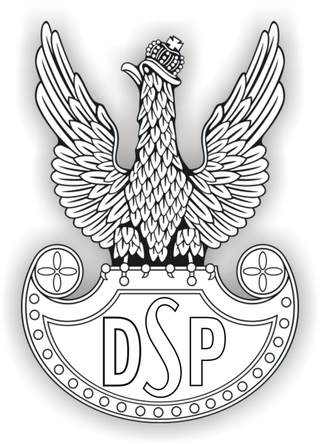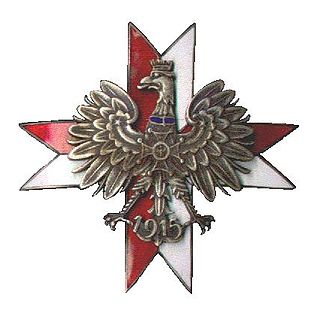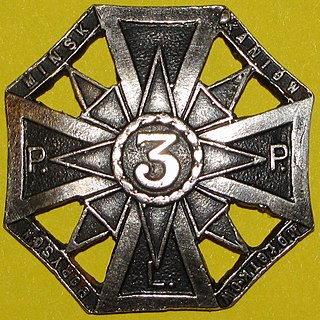
Operation Tempest was a series of uprisings conducted during World War II against occupying German forces by the Polish Home Army, the dominant force in the Polish resistance.

The 28 Dywizja Piechoty was a Polish Army infantry division which saw action against the invading Germans during the Invasion of Poland of World War II. The division suffered heavy casualties in battles near Łódź and the remnants retreated to Warsaw, where they surrendered.

The 36th Infantry Regiment of the Academic Legion was a Polish military unit. Initially made up of students from the University of Warsaw and the Warsaw University of Technology, it fought with distinction in the Polish-Bolshevik War, the Polish Defensive War and in the Warsaw Uprising.

The 7th Infantry Division was the name of several units of the Polish Army.
The 8th Infantry Division was a tactical unit of the Polish Army. It was active in the Polish-Bolshevik War, as well as during the Invasion of Poland in 1939. During World War II, the division was reformed twice as part of two distinct armed forces: once as part of the Home Army during the Warsaw Uprising and again as part of the Polish Army in the East.
Polish 2nd Legions Infantry Division was a tactical unit of the Polish Army between the World Wars. Formed on February 21, 1919, in the towns of Zegrze and Jablonna near Warsaw, and composed mostly of veterans of the Polish Legions in World War I, the unit saw extensive action during the Polish-Bolshevik War and the Invasion of Poland.
The Polish 4th Infantry Division was created following Polish independence after the end of World War I. The division participated in the Polish–Ukrainian War in 1919. During World War II, the division existed as three wholly separate organizations, the original incarnation of the division as part of the pre-war Polish Army, the second incarnation armed and equipped by the western Allies, and another division armed and equipped and controlled by the Soviet Union. The second and third incarnations of this division existed simultaneously from 1944 until 1947.

The 2nd Rifle Division was a Polish Army unit, part of the recreated Polish Army in France in 1940.

The 18th Infantry Division is a division of the Polish Armed Forces. The division was originally part of Polish Army during the interbellum period, which took part in the Polish September Campaign. Stationed in Łomża and commanded in 1939 by Colonel Stefan Kossecki, it was part of the Narew Independent Operational Group.

The 9th Infantry Division was a unit of the Polish Army in the Second Polish Republic. For most of 1919, the 9th Division's regiments were dispersed across the regions of Podlachia, Polesie and Volhynia, with one battalion sent to Dąbrowa Basin.

15th "Greater Poland" Infantry Division was a unit of the Polish Army in the interbellum period. Founded on February 17, 1920, and based on the 2nd Greater Poland Rifles Division, it actively participated in the Polish-Soviet War, including the Kiev offensive (1920), and the Battle of Warsaw. After Polish victory, the Division pushed the Red Army out of northern Mazovia. It then fought in the Battle of the Niemen River.

The 27 Infantry Division, was a unit of the Polish Army in the inter-war period. It was created on 18 October 1920, as a result of reorganization of the Army, from units of the 2nd I.D., 3rd I.D., and 13th I.D. Its headquarters were located in Kowel, with units stationed in other Volhynian towns, such as Lutsk, Sarny and Wlodzimierz Wolynski. The Division's first commandant was General Gustaw Kuchinka.

14 Greater Poland Infantry Division was a unit of the Polish Army in the interbellum period, which took part in the Polish September Campaign.
The 11th Carpathian Infantry Division, was a tactical unit of the Polish Army in the interbellum period, which fought in the Invasion of Poland in 1939. Elements of the unit would go on to serve in the Polish Armed Forces in the East.

The 12th Bolesław KrzywoustySzczecin Mechanised Division is a division of the Polish Armed Forces, headquartered in Szczecin.
5th Lwów Infantry Division was a unit of the Polish Army in the interbellum period, with headquarters stationed in Lwów. It was created on May 20, 1919, during the Polish–Ukrainian War in Eastern Galicia. Originally, it consisted of three infantry regiments, but later it was strengthened with additional two. During Polish September Campaign it was commanded by General Juliusz Zulauf. The Division consisted in September 1939 of these regiments:
The 36th Reserve Infantry Division was a unit of the Polish Army in the interbellum period, which took part in the Polish September Campaign.

The First Krechowce Uhlan Regiment was a mounted unit of the Polish Army, active in the Second Polish Republic. Its traditions were continued during World War II, by a regiment of the same name, which was part of Polish Armed Forces in the West. The First Krechowce Uhlan Regiment was formed in 1915, as a unit of the Imperial Russian Army. It fought in World War I, Polish–Soviet War and the Invasion of Poland, as part of Suwalska Cavalry Brigade. Until 1939, the regiment was stationed in Augustów. It ceased to exist in 1947. The first commander of the regiment was a Tsarist officer of Polish ethnicity, Colonel Bolesław Mościcki, who was killed in 1918 near Luninets. The last commander was Colonel Leon Strzelecki.

3rd Legions' Infantry Regiment was an infantry unit of Polish Legions in World War I, Polish Army and the Home Army. It existed in 1914–1939 and 1944–1945.

Jan Edward Dojan-Surowka was a soldier of the Polish Legions in World War I and Colonel of Infantry in the Polish Army in the interwar period.














